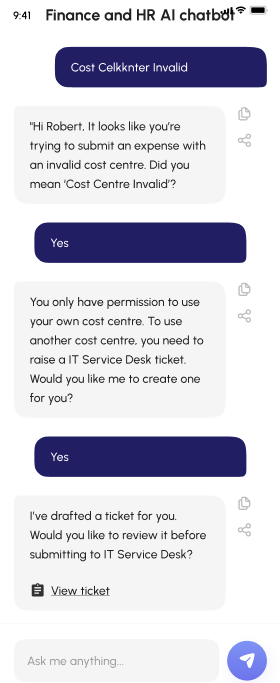When designed right, chatbots offer a fast, low-cost way to support basic interactions. More complex issues can be triaged to human agents in contact centres.
However, chatbots are often developed without an expert — like a content designer — to design conversation flows.
This was evident during the pandemic, where chatbots were deployed as a quick fix to handle repetitive customer queries.
The rush to release chatbots created poor user experiences. Chatbots were programmed using rigid, decision-tree systems that mimicked digital phone menus and disguised them as chat interfaces. They could only handle exact scenarios. Any deviation led to the dreaded "I’m sorry, I don't understand" response.
The result? Frustrated customers.
Now we’re in the AI age, things are different. Conversational AI-based chatbots are here. They use technologies like natural language understanding, natural language processing and AI to decide the most appropriate response. You can have open-ended, seemingly realistic conversations.
But AI can’t solve poor content
I’ve been designing content for long enough to see new technologies and systems emerge. Often the value promised is getting the right content to the right individual at the right time. Content design 101. But what these technologies often mask is something fundamental: it’s your content that needs sorting out.
Intranet not working? You’ve got a content quality and governance problem.
Personalisation? If your underlying content is poor, you’re going to personalise poor content. Is that what you want your customers to experience?
We recently helped a financial services provider improve their chatbot with AI. It was a basic, hardcoded chatbot, handling staff questions about expenses and purchasing. It was prone to errors and, as a result, use was low.
Yes, the chatbot experience could be improved with AI. But that wasn’t the real problem — it was the content behind it. Key information was scattered across different systems, written by different teams, often duplicated, out of date, or contradictory. With no governance to keep it consistent, any AI-powered chatbot would struggle to answer simple queries to a degree of certainty.
Fixing the basics first
This is not often what people want to hear, but if you do the foundational work right, you create the platform for product innovation through AI-powered solutions.
In our financial services examples we gave the client 5 recommendations:
- Audit and remove/rewrite existing policy content.
- Create a knowledge base that becomes the single version of the truth. Provide a content governance framework to support it.
- Solve core user tasks first. Provide value quickly to build trust.
- Develop integrations with other platforms. Join up the user experience to remove friction.
- Release incremental AI features. Create greater sophistication over time.
By doing this, the chatbot could be developed incrementally, making sure it continued to meet user needs with each iteration.
Building an AI chatbot on these foundations
With these foundations in place, our AI chatbot was capable of offering intelligent, user-friendly interactions, including:
1. Recognising intent
The ability to understand the goal or purpose behind what the user is asking, so it can respond appropriately. User needs, essentially.
2. Interpreting natural language
The ability to handle real, human ways of speaking to enable smooth, conversational interactions. So no dead ends if the question isn’t phased exactly as expected.
3. Forgiving spelling errors
The ability to accurately interpret what a user is trying to say, even when it contains typos or mistakes, so users don’t get stuck on minor slip-ups.
Here’s a future state example of the financial services chatbot in action:

- The bot knows who the user is and what they are trying to do. It just asks a few clarification questions to make sure.
- It forgives spelling errors, because let’s face it - who can type properly these days?
- It pulls the expenses policy from the knowledge base, which is maintained by the content governance framework to ensure accuracy.
- It integrates with the IT system, automatically generating a support ticket for the user. This reduces error rate for support queries — a key business metric.
But all this is only made possible by fixing the basics and getting your content in order.
Get in touch
Great technology only works with great content. Contact Daf to find out how to align your content strategy with AI to deliver measurable results.

